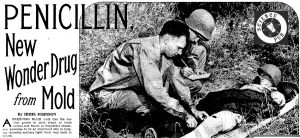An ongoing dialogue on HIV/AIDS, infectious diseases,
June 24th, 2014
At Long Last, Some New Antibiotics That Might Make a Difference
 Compared to HIV, HCV, and antifungal agents, development of novel antibacterial drugs has been in a bit of a funk for quite some time now.
Compared to HIV, HCV, and antifungal agents, development of novel antibacterial drugs has been in a bit of a funk for quite some time now.
Here’s what’s been approved in the past 10 years, with year of approval and a few comments:
- Telithromycin (2004): The first ketolide antibiotic, it was supposed to overcome macrolide-resistant respiratory pathogens. But there were huge controversies about the clinical trials that led to its approval, and major concerns about liver and other adverse effects. It’s still available, but no one in their right mind would use it.
- Tigecycline (2005): Although this incredibly broad-spectrum tetracycline-like agent seemed like just the ticket based on its in vitro activity, clinical experience has been only fair at best. It achieves low blood levels, so isn’t suitable for bacteremia, and is associated with extremely high rates of nausea. Plus there’s this excess death issue in pooled data from several clinical trials — never a good thing!
- Doripenem (2007): The most recently approved carbapenem, doripenem was shown to be inferior to imipenem for ventilator-associated pneumonia, with a lower rate of cure and a higher risk of death. (Bad.) That trial alone — sponsored by the makers of the drug, no less — should be sufficient reason never to prescribe it.
- Telavancin (2009): A relative of vancomycin, telavancin is approved for skin infections. It appears to be more nephrotoxic than vancomycin, however, and offers few advantages. I still have never prescribed it, and our ID PharmD says there has been only one patient in our hospital’s history who has received it.
- Ceftaroline (2010): The first cephalosporin with anti-MRSA activity, ceftaroline has a relatively narrow list of FDA-approved indications — namely, community-acquired pneumonia (who would use it for this?) and skin and soft tissue infections. As a result, the drug is really still trying to find itself, if I may personify Mr. C. Fosamil for a moment. What we’d really like to know is how it does for MRSA bacteremia and other severe infections, but thus far the data for these indications are quite limited.
- Fidaxomicin (2011): This novel treatment for C. diff may be slightly more effective than vancomycin, at least in certain populations. It is extremely expensive — it’s the current winner in the “Most Expensive Oral Antibiotic” competition — so anecdotally it’s almost always used as a second-line or salvage therapy. In addition, FMT and other microbiome-restoring treatments may ultimately make use of antibiotics for C. diff of limited use.
I’ve probably left some antibacterial out from the above list (did it by memory, except for the FDA approval dates — always risky), but think this pretty much covers the decade. Aside from ceftaroline — which again, is still kind of in a transitional phase as we gather more data — it’s not a particularly impressive group of drugs.
Hence the recent approvals of dalbavancin and tedizolid, and the likely upcoming approvals of oritavancin, ceftazidime/avibactam and ceftolozane/tazobactam, all give ample reason for hope. These incentives seem to be working!
Dalbavancin and oritavancin, with their prolonged half-lives and infrequent administration, could “profoundly affect how skin and soft tissue infections are managed, by reducing or in some cases eliminating costs and risks of hospitalization,” to quote this nice editorial in the New England Journal of Medicine.
Tedizolid is (finally) an alternative to linezolid, with once-daily dosing and likely a better safety profile.
And the two new cephalosporin/beta-lactamase inhibitor combos could provide much-needed options for highly resistant gram negative infections, which we hope would obviate or at least reduce the use of tigecycline and colistin.
Sure, we still need to see these drugs in the “real world” before we know about effectiveness, tolerability, safety, and price. But I’m cautiously optimistic.


Thanks as always for some very insightful comments Dr. Sax!
I agree that there has been some progress made, especially in the anti-Gram-positive arena. I am still concerned regarding the new drugs against Gram-negatives however, as NDM’s still seem to escape, and these new combos will likely just replace Vitamin Z (Zosyn) in the overuse arena.
Until some completely novel drugs actually come online and are approved for “real” indications (i.e., bacteremia), and we have increased support (locally, nationally, and internationally) for stewardship, I don’t think I can share your optimism.
Thanks for the nice summary.
Oddly enough, seems like the AAP has changed its tone when it comes to treating acute otitis media, liberalized the prescription of Amoxicillin… no wonder we see so many kids on amoxil for indications like “chest infection” or just to treat a fever!
Antibiotics stewardship and up to date local resistance patterns publication completely changed how I use anti-infectives.